Cervical Facet Syndrome
A common complaint after whiplash
Keyword; cervical facet syndrome.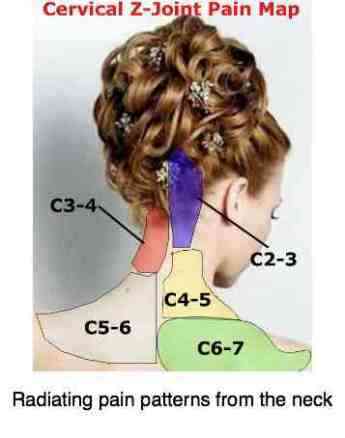
This neck pain condition faces the chiropractic physician on a daily basis. Neck pain, headache and, less commonly, pain or tingling radiating down the arm, but more frequently to the region between the shoulders.
The cause? Quite simply, trauma, and sometimes poor posture. For example sleeping on your stomach. For years medicine has been in denial that whiplash, and other related trauma, can and frequently does cause injury to the various tissues in the neck. In a 10 year follow up study after whiplash, only 12 percent of the victims reported that they had absolutely no symptoms and had healed completely.
In another study reported in Spine, a prominent medical journal, fully 60 percent of whiplash patients were found to be suffering from a Cervical Facet Syndrome.
There is oodles of research now on whiplash, done by a whole range of specialists, chiropractic, orthopedic, neurological and radiological confirming the importance of the Cervical Facet Syndrome.
Cervical Facet Syndrome
The vertebrae, the ligaments, the muscles, the nerves, the discs and the facets (aka Z-joints) are all vulnerable to whiplash. Other more nebulous tissues too, like the fascia, of course the cord itself, and the blood vessels. Now there is overwhelming evidence that whiplash does cause permanent injury, and the cervical facet syndrome is one of the most traumatised tissues.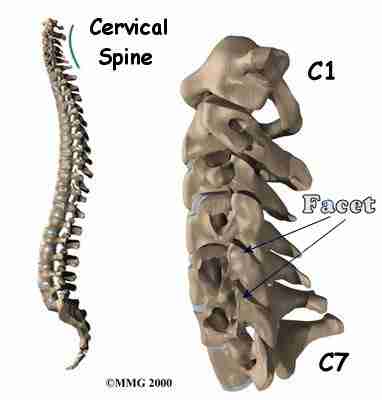
The facet joints in the neck have quite different shapes and orientations depending on their location, so the presentation varies quite dramatically according to which facet is involved. Very broadly, and frankly this is an over-simplification, we can divide the cervical facet syndrome into four different types:
The Atlanto Occipital joint (C0-C1)
These two joints, right and left, lie between the base of the skull known as the occiput; and the first bone in the neck, called the atlas. Hence the name atlanto occipital joint. It is at this joint that nodding movements of the skull on the neck occurs; small up and down movements, adjusting the head position in relation to the monitor in front of you, for example.
Subluxation of these joints causes a deep ache at the very top of the neck, often causing severe headaches. A large artery supplying the base of the brain winds it's way around this joint.
Chiropractic help uses a variety of techniques including manipulation; the Chiropractic adjustment. Sometimes the atlanto occipital joint is the problem; or that at the atlanto axial level.
Subluxations of this joint can cause widely differing symptoms such as vertigo and loss of balance. Medically this is often causes a condition called benign positional paroxysmal vertigo, and sometimes Meniere's disease, if it there is associated deafness and ringing in the ear. However, in my experience, Meniere's is often wrongly diagnosed, the cause being either at this joint, or that condition in the inner ear, called BPPV that is very treatable with new techniques called the Epley Maneuver; this is a short course for chiropractors wanting to learn the Epleys.
Atlanto Axial joint anatomy (C1-C2)
These joints are quite different to C0-C1. It is here that most of the rotation of the neck occurs. Subluxations of the atlas are one of the causes of a severe stiff neck, often associated with headache too.
For more about the anatomy of the atlas, and the cervical facet syndrome, Click here. ATLANTO AXIAL JOINT ANATOMY >>
C2-C3
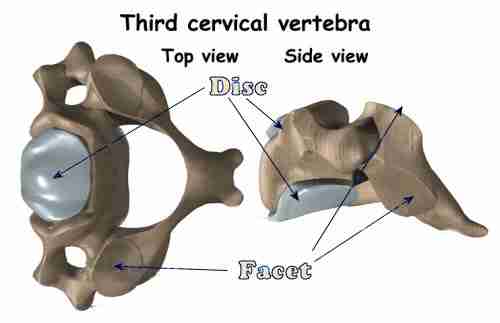
See those 'facet joints'? They are lined with glistening white hyaline cartilage. When healthy it's very hard but, because it has no blood supply, it's very dependent on certain physiological factors for health and restoration after injury. The alternative is arthritis, stiffness and pain. Read more ...
Chiropractic help for Lower neck and arm pain(C4-T1)
Facets in the mid-to-low cervical spine again are rather different in orientation and also, by virtue of the fact that the nerves emerging from the region supply the shoulder and arm, the Cervical Facet Syndrome presents rather differently.Thus headache is less of a feature in this region. Rather, the fixations cause stiffness of the neck, and associated tightness and pain in the shoulder muscles.
Whiplash research
Just adjacent to the facets, small joints often injured in whiplash are found. Known as the CHIROPRACTIC HELP Whiplash and the JOINTS of LUSCHKA; they also contribute to radiating pain down the arm.- More about UncoVertebral Joint Luschka ...
- Whiplash research
Testing for a pinched nerve
A frank pinched nerve in the lower neck is tested using the Upper Limb Tension Test ... arm pain, repetitive strain injury of the arm, especially at the computer (mouse arm) usually have a neurogenic origin.
TMJ anatomy
Because the sensory Trigeminal nucleus of the nerve supplying the jaw joint is found in the upper neck, in the region C1-C3, sensory information from the cervical facets feeding into that same nucleus, neck pain and jaw joint pain (TMJ) often go hand in hand.
Between them, the cervical facets and the TMJs are the major cause of blinding Migraine headaches, though it must be recognised there are many causes of migraine. For more about headache in general, and the association between the TMJ and migraine, click here.
ARM PAIN
The whole arm becomes vulnerable.
The nerves emerging from this region supply the shoulder and arm. Should there be nerve involvement then the pain, tingling and numbness may spread into the arm, causing obscure arm pain and making you will be vulnerable to shoulder pain, conditions such as
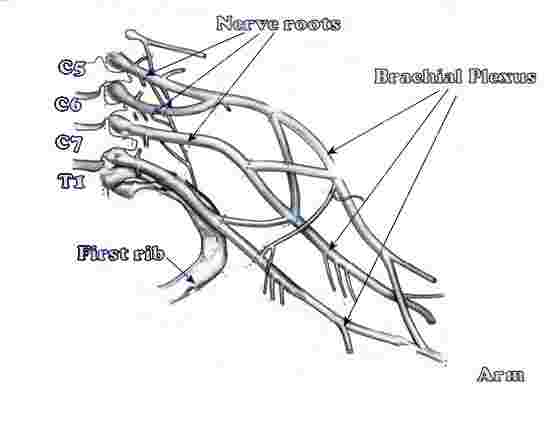
To understand the low cervical facet syndrome properly you need to have some grasp of the low cervical facet anatomy.
The the basis of your arm pain be a pinched or irritated nerve in the neck? The basic test for a pinched nerve in the neck is known as the Upper Limb Tension Test ...
CHIROPRACTIC HELP NECK PAIN TREATMENT
Mostly, though not always, the cervical facet syndrome is bread and butter for the chiropractor. Only rarely are there complications, such as after recent trauma or in very degenerate joints. On any average day, s/he will be treating numerous people with this condition.
The treatment will involve soft-tissue work of any associated muscle spasm, perhaps manual traction, and then manipulation. This manipulation is not ordinarily particularly painful, but may be a little unnerving at the first couple Chiropractic help treatments.
The cartilage lining these facet joints is very dependent on normal movement of the joint for their nutrition. Jamming of the joints that is not attended to leads to what is called Immobilisation Arthritis ...
- Read more about Early symptoms of ARTHRITIS …
- Neck pain anatomy ...
- Read more about NECK PAIN …
- STIFF NECK EXERCISES for neck pain and stiffness ...
- The Standard Diagnostic Test for this condition. CERVICAL COMPRESSION TEST ... A fun page; don't miss it!
Read more about CHIROPRACTIC NECK PAIN TREATMENT …
Iatrogenic Illness
It is acknowledged that there is some risk associated with all treatment, including Chiropractic.
Have a problem that's not getting better? Looking for a different slant on your pain? Want to pose a question?
Sleeping on your tum
The joints of the spine do not have a direct blood supply. Rather they are dependent for their nutrition on fluids bathing the cartilage. During the night, free from gravity, these fluids are refreshed, infusing the joint. You literally get taller. That's one of the reasons why we are all stiff in the morning, and need to stretch. Take a hint from your cat.
Then, during the day, with the weight of gravity, the fluids are squeezed out again, taking noxious waste products with them.
This is a very important process for the normal nutrition of the cartilage. Starved of oxygen and nutrients, and the build up of waste products of metabolism, the joint cartilage very quickly begins to degenerate and become arthritic; within 13 hours in white mice.
Sleeping on your tum, with your head turned all night, keeps the joints under tension, stopping this nutritional pump from feeding the tissues of the neck adequately. The result? Pain and early arthritis of the neck joints.
From an early age, do not put your children to sleep on their tums, as advocated by the famous Dr Spock. There is an increase in cot-deaths, and they will get into a life long habit of sleeping on the stomach that is difficult to break.
Prevention
Prolonged flexion of the neck puts the cervical facets and muscles under arduous strain. Every home and office should have one of these. It will pay for itself in weeks. Increased productivity, less absenteeism due to headache and visits to the doctor and chiropractor. Fewer mistakes from a drugged worker struggling with a headache.
The Posturite costs around 100 pounds. Click on the graphic for details ...wonderful for the Cervical Facet Syndrome. My wife, a teacher, wouldn't be without her Posturite. She uses it EVERY day.
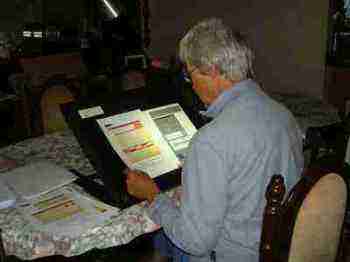
Think too about your bedside lights; having to crane your neck to get sufficient direct light is certainly one cause of neck pain.
Cervical myelopathy
Whether due to severe injury, and thus with the best will in the world this was going to happen anyway, or to neglect, the Cervical Facet Syndrome can sometimes lead to such severe degeneration that it can effect the spinal cord, and ultimately cause weakness and disability in the legs. A standard procedure is the Ten Second Step Test.- Read more ... Ten second step test ....
- Symptoms of cervical stenosis ...
Self manipulation
There are few more damaging things for the spine than self manipulation. And I'm not being a humbug, suggesting you pay your chiropractor when you could be treating yourself for free.During a chiropractic manipulation, your doctor will distract the joint so there is no cartilage on cartilage contact during the procedure. Self manipulators can't do that, and trauma occurs every time to you click your own neck; or any joint for that matter.
Add to that you cannot do it properly, so you gain very temporary relief. Self manipulators end up popping their own necks half a dozen or more times a day; we think that a joint shouldn't be manipulated more than perhaps twenty five times a year. Self manipulators achieve that in a week; it's severely traumatic for the spine.
A severely damaged nerve root and aweful pain radiating down the arm will be the result. Prove me wrong! I've seen it so often.
HOME TRACTION UNIT
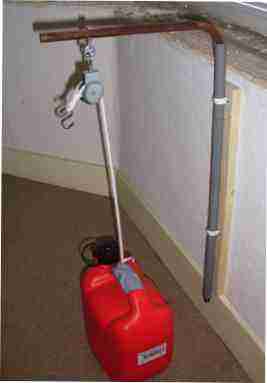
USEFUL LINKS @ CERVICAL FACET SYNDROME
- Neck exercises and a simple test for neck strength. JULLS TEST ...
- From CERVICAL FACET SYNDROME to VERTIGO DIZZINESS ...
- Whiplash Chiropractic ... always consult a chiropractor after an accident to prevent Immobilisation Arthritis.
- The joint at the base of the skull can be the cause of severe headaches. ATLANTO OCCIPITAL JOINT ...
- A classification system for neck pain ... how bad is your pain?
- Go from cervical facet syndrome to CHIROPRACTIC HELP home page …
Did you find this page useful? Then perhaps forward it to a suffering friend. Better still, Tweet or Face Book it.
Interesting challenges of the day
1. Mr S is a 76 year old man with neck pain of some 9 months duration. Luckily, most of the discomfort is upper cervical which is only rarely arthritic; his lower cervical spine is a degenerative mess that I've left alone. After seven treatments his pain and stiffness is 50 percent better, and he's happy in the circumstances. He can sleep through the night now and that makes a huge difference.
2. Mr P is 32 year old man with very severe lower back pain radiating to the big toe which is 30 percent numb. He had an episode three weeks ago, took anti inflammatories and was soon better as is typical of the medial disc herniation. But before it healed, after a trivia it came roaring back, much worse. The characteristic crossed sign was evident; sitting in a chair, straightening the right leg provoked severe left back pain and tingling in the leg. He's doing well.
3. Mrs T looked like the leaning tower of Pisa; she had a slipped disc at L5 making her lean towards the opposite side. It's called the postero lateral hernia; she's much better after two weeks of treatment and will go back to work next week, part time.
Lateral discs are more difficult; both take a minimum of six weeks to heal. In my opinion, antalgic patients need what I call exercising bed rest. Sit and it won't get better.
4. Mr S has had lower back, groin and back of thigh and calf pain for fourth months.
He has a pincer deformity in the hip causing the stabs in the groin, and a degenerative facet causing the sciatica. Both are responding well to chiropractic and he's well pleased; sixty five percent better after three treatments.
5. Mr T is a wise man; he's taken a warning TIA seriously and has lost 15 pounds, and has at least as much again to lose. A change to a low starch diet and half hour daily walk has made the difference; but the walking is making his foot and back miserable. The expensive orthotic is hopeless; luckily his hips and back are fine, but he needs a simple heel lift.
6. I too have had serious lower back issues, luckily fixed by my own chiropractor; so I too have to do my exercises, take care when lifting supers full of honey, gardening and using the chainsaw. Regaining the function of your spine is just as important as the pain.
7. My own granddaughter, only 7 is hypermobile giving her pelvic, knee and ankle issues. Xrays show a mildly dysplastic hip. Years ago we would have called it growing pains. She too regularly needs chiropractic care and luckily responds well. Increased range of motion is more difficult than too stiff in my opinion. Our care is for kids too.
8. This 65 year old lady is a serious gardener; every day she is bending, lifting and digging for 2 to 3 hours a day. It regularly catches her in the sacroiliac joint, so she has a treatment once a month that sorts it out. She does her lower back exercises faithfully.
9. This 88 year old lady is an inspiration; every day she is busy in the community. With a nasty scoliosis she manages very well with a chiropractic adjustment every six weeks and exercises faithfully done.
10. Mr X is a 71 year old retired man who wants to continue with maintenance care every six to eight weeks; he had suffered from two years of lower back pain when he first came a year ago. He has no discomfort now after 8 chiropractic treatments, but is aware that danger lurks.
11. Mrs C has been having severe headaches, and taking a lot of analgesics. It's a non complicated upper cervical facet syndrome, and she's doing well.
12. Mr D is a 38 old year man with chronic shoulder pain after a rotator cuff tear playing cricket. It responded well to treatment, but he knows he must do his exercises every day; for two years he couldn't sleep on that shoulder.
13. Mr D, a 71 year old man, has a severe ache in the shoulder and midback since working above his head. Trapped nerve tests are negative but he has advanced degenerative joints of Luschka; after just two treatments he is 50 percent better. Can we reach 90?
And so the day goes; chiropractors shouldn't be treating the elderly most medical sites state but that's so much bunkum.
1. Mr S is a 76 year old man with neck pain of some 9 months duration. Luckily, most of the discomfort is upper cervical which is only rarely arthritic; his lower cervical spine is a degenerative mess that I've left alone. After seven treatments his pain and stiffness is 50 percent better, and he's happy in the circumstances. He can sleep through the night now and that makes a huge difference.
2. Mr P is 32 year old man with very severe lower back pain radiating to the big toe which is 30 percent numb. He had an episode three weeks ago, took anti inflammatories and was soon better as is typical of the medial disc herniation. But before it healed, after a trivia it came roaring back, much worse. The characteristic crossed sign was evident; sitting in a chair, straightening the right leg provoked severe left back pain and tingling in the leg. He's doing well.
3. Mrs T looked like the leaning tower of Pisa; she had a slipped disc at L5 making her lean towards the opposite side. It's called the postero lateral hernia; she's much better after two weeks of treatment and will go back to work next week, part time.
Lateral discs are more difficult; both take a minimum of six weeks to heal. In my opinion, antalgic patients need what I call exercising bed rest. Sit and it won't get better.
4. Mr S has had lower back, groin and back of thigh and calf pain for fourth months.
He has a pincer deformity in the hip causing the stabs in the groin, and a degenerative facet causing the sciatica. Both are responding well to chiropractic and he's well pleased; sixty five percent better after three treatments.
5. Mr T is a wise man; he's taken a warning TIA seriously and has lost 15 pounds, and has at least as much again to lose. A change to a low starch diet and half hour daily walk has made the difference; but the walking is making his foot and back miserable. The expensive orthotic is hopeless; luckily his hips and back are fine, but he needs a simple heel lift.
6. I too have had serious lower back issues, luckily fixed by my own chiropractor; so I too have to do my exercises, take care when lifting supers full of honey, gardening and using the chainsaw. Regaining the function of your spine is just as important as the pain.
7. My own granddaughter, only 7 is hypermobile giving her pelvic, knee and ankle issues. Xrays show a mildly dysplastic hip. Years ago we would have called it growing pains. She too regularly needs chiropractic care and luckily responds well. Increased range of motion is more difficult than too stiff in my opinion. Our care is for kids too.
8. This 65 year old lady is a serious gardener; every day she is bending, lifting and digging for 2 to 3 hours a day. It regularly catches her in the sacroiliac joint, so she has a treatment once a month that sorts it out. She does her lower back exercises faithfully.
9. This 88 year old lady is an inspiration; every day she is busy in the community. With a nasty scoliosis she manages very well with a chiropractic adjustment every six weeks and exercises faithfully done.
10. Mr X is a 71 year old retired man who wants to continue with maintenance care every six to eight weeks; he had suffered from two years of lower back pain when he first came a year ago. He has no discomfort now after 8 chiropractic treatments, but is aware that danger lurks.
11. Mrs C has been having severe headaches, and taking a lot of analgesics. It's a non complicated upper cervical facet syndrome, and she's doing well.
12. Mr D is a 38 old year man with chronic shoulder pain after a rotator cuff tear playing cricket. It responded well to treatment, but he knows he must do his exercises every day; for two years he couldn't sleep on that shoulder.
13. Mr D, a 71 year old man, has a severe ache in the shoulder and midback since working above his head. Trapped nerve tests are negative but he has advanced degenerative joints of Luschka; after just two treatments he is 50 percent better. Can we reach 90?
And so the day goes; chiropractors shouldn't be treating the elderly most medical sites state but that's so much bunkum.
Have a problem that's not getting better? Looking for a different slant on your pain? Want to pose a question?
Interesting questions from visitors
Greetings, Dr B.
You helped me quite some time back with a soothing and professional response which turned out to be exactly correct. I now consult a local chiropractor. You write a superb newsletter, too.
- Tingling and frozen fingers in right hand with pain in upper arm and shoulder after a serious MVA. by Len.
- Persistent femoral nerve pain.
by Alex.
- Is this my back? by Anne
- Tietzes syndrome costochondritis by Virginia
Knowing that up to 70% of the time the correct diagnosis is made with no examination, no special tests, no xrays, but just from the history, there's a fair chance I can add some insight to your unresolved problem. But at least 30% of the time, I may be quite wrong! Give plenty of detail if you want a sensible reply.
You visited this chiropractic help site no doubt because you have a problem that is not resolving and want to know more about what chiropractors do.
The quickest and most interesting way is to read one of my ebooks of anecdotes. Described by a reader as gems, both funny and healthful, from the life and work of a chiropractor, you'll love them. Priced right at $2.99, though Kindle fiddles the price without telling me.
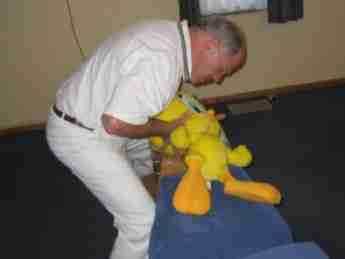

No comments:
Post a Comment